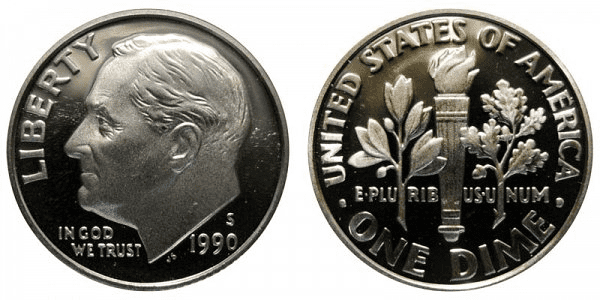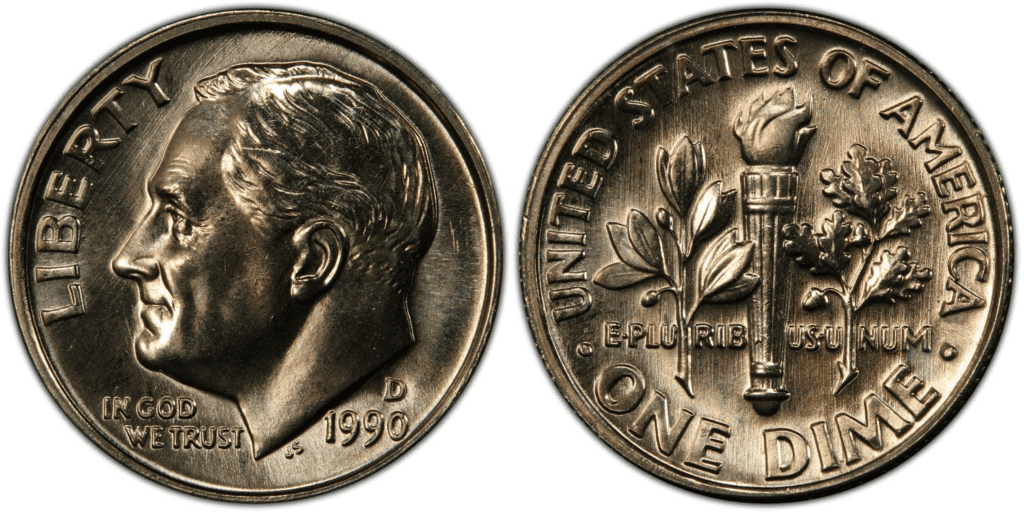What Is the 1990 Roosevelt Dime Made Of?
The Roosevelt Dime has acted as a constant reminder of President Franklin D. Roosevelt’s support for the March of Dimes and his attempts to eradicate polio since it first entered circulation in 1946. The design was made by Chief Engraver John Sinnock in response to a 1945 request from Congress for a new dime. In 1946, Sinnock’s creation made its premiere, replacing the earlier Winged Liberty Dime.
A bust of President Roosevelt looking to the right is depicted on the coin’s obverse side. The right field and margin contain the phrases “LIBERTY” and “IN GOD WE TRUST.” To the lower left of Roosevelt’s bust, you can discern Sinnock’s initials and the year of mintage. The primary design on the coin’s reverse is a flame, which stands for liberty. There is only one group of olive branches on either side of the flame. In the space between each branch and the flame, the phrase “E PLURIBUS UNUM” is written. The words “ONE DIME” and “UNITED STATES OF AMERICA” are written above and under the image, respectively.
Prior to 1965, Roosevelt Dimes contained silver, but after this, they were made of 75% copper and 25% nickel. 1990 Dimes weigh was 2.27 grammes, and have a diameter of 17.9 mm. The edge of the coin has reeding.
Roosevelt dimes haven’t drawn as much attention from collectors as other coin kinds, despite being one of the most persistent currency series now in use in the United States. This might be in part because, with the exception of a few variant coins or a few low-mintage coins, the series lacks notable rarity.
The launch of the Hubble Space Telescope, Nelson Mandela’s release from prison, the unification of Germany, and Margaret Thatcher’s resignation are just a few important 1990 events. The Gulf War Crisis began in this year as well, and Tim Berners-Lee developed the first web server in the fall to build the groundwork for the World Wide Web.
1990 Roosevelt Dime Varieties
1990 P Roosevelt Dime
Year of minting: 1990
Face Value: $0.10
Composition:75% Copper and 25% Nickel
Total Weight: 2.27 grams
Diameter: 17.91 millimeters
Thickness: 1.35 millimeters
Edge: 115 Reeds
Minted in: Philadelphia
Mint Quantity: 1,304,340,000

1990 D Roosevelt Dime
Year of minting: 1990
Face Value: $0.10
Composition:75% Copper and 25% Nickel
Total Weight: 2.27 grams
Diameter: 17.91 millimeters
Thickness: 1.35 millimeters
Edge: 115 Reeds
Minted in: Denver
Mint Quantity: 839,995,824

1990 S Roosevelt Dime
Year of minting: 1990
Face Value: $0.10
Composition:75% Copper and 25% Nickel
Total Weight: 2.27 grams
Diameter: 17.91 millimeters
Thickness: 1.35 millimeters
Edge: 115 Reeds
Minted in: San Francisco
Mint Quantity: 3,299,559

List Of 1990 Roosevelt Dime Errors
Full Band 1990 Roosevelt Dime

Several series, including Roosevelt Dimes, are evaluated not only based on circulation wear but also on the existence of certain characteristics that are identified by unique grading designations.
Full Bands refers to the horizontal twin bands that can be seen on the torch that lights the reverse of this well-known coin in the case of the Roosevelt Dime, which is the specific grade-related designation in question.
An oak tree and an olive branch, which collectively stand for power, peace, and liberty, flank the torch on either side. Since 1946, many billions of Roosevelt Dimes have featured the design by sculptor-engraver John R. Sinnock, although only a relatively small percentage do so in the way that Sinnock intended. The completeness of the design on so many of these pieces is hampered, as is frequently the case with coins, by strike flaws. The bands on the torch are one of the sections that are most prone to not having all of their details, something that is particularly noticeable on copies of business-strike samples that have been circulated.
Mint condition examples of 1990 Roosevelt Dimes with this distinction can be worth between $110 and $2,500.
Miscellaneous Errors
Of course, with so many coins minted each year, a few error coins are bound to reach the general population. While there are no broadly recognized errors for this mintage year, there are still some relatively common errors to be on the lookout for. Clipped planchet coins can reach around $30, off centre strikes reach between $10 and $20. Broadstrike errors are worth a little less at between $5-$10, while 1990 Roosevelt Dimes missing their clad layers are worth about $20.
How Much Is 1990 Roosevelt Dime Worth Today?
Due to the removal of any silver content, the 1991 Dime’s face value is worth five times more than its melt value, which is merely $0.024 due to the lack of precious metal in the coin. The values for 1990 dimes are listed in the table below:
| Coin | MS65 | PR65 |
| 1990 P Roosevelt Dime | $2.81 | – |
| 1990 D Roosevelt Dime | $2.81 | – |
| 1990 S Roosevelt Dime Proof | – | $2.81 |
How Does The Grading System Work?
The Sheldon Scale is used by numismatists to provide a numerical value to coins. The Sheldon Scale goes from poor (P-1) to perfect mint state (P-1) (MS-70). Coins were originally evaluated using words to reflect their condition (Good, Fair, Excellent, Etc.). Unfortunately, coin collectors and dealers had different ideas about what each of these terms represent.
Professional numismatists joined together in the 1970s and established coin grading standards. These numismatists now assign grades at key places on the seventy-point scale, using the most regularly utilized numeric points in conjunction with the original adjective grade. The following are the most common coin grades:
- (P-1) Poor – Indistinguishable and probably damaged; if used, must have a date and mintmark; otherwise, rather battered.
- (FR-2) Fair – Nearly smooth, but without the damage that a coin graded Poor often possesses. The coin must have enough detail to be identified.
- (G-4) Fair – Inscriptions have merged into the rims in some areas, and important elements have been mostly erased.
- (VG-8) Very Good- A little weathered, but all of the primary design elements are visible, albeit faintly. There is little if any, central detail left.
- (F-12) Good – The item is very worn, yet the wear is even, and the overall design details stand out clearly. Rims are almost completely isolated from the field.
- (VF-20) Very Fine – Moderately weathered, with some finer features still visible. The motto or all letters of LIBERTY are readable. Both sides of the coin have entire rims that are separated from the field.
- (EF-40) Extremely Fine – Gently used; all gadgets are visible, and the most important ones are bold. The finer details are bold and clear, however, light wear may be seen.
- (AU-50) Uncirculated – Slight evidence of wear on the coin’s design’s high points; may have contact marks; eye appeal should be adequate.
- (AU-58) Uncirculated Choice – Slight traces of wear, no severe contact marks, almost full mint shine, and great eye appeal.
- (MS-60) Mint State Basal – Strictly uncirculated; no indication of wear on the coin’s highest points, but an unsightly coin with reduced luster, visible contact marks, hairlines, and other flaws.
- (MS-63) Mint State Acceptable – Uncirculated, but with contact scratches and nicks, little reduced shine, but otherwise appealing appearance. The strike is weak to average.
- (MS-65) Mint State Choice – Uncirculated with great mint shine, very little contact blemishes, and exceptional eye appeal. The strike is unusually severe.
- (MS-68) Mint State Premium Quality – Uncirculated with superb luster, no obvious contact marks to the naked eye, and exceptional eye appeal. The strike is quick and appealing.
- (MS-69) Almost Perfect Mint State – Uncirculated with perfect brilliance, a sharp and appealing strike, and extremely good eye appeal. A near-perfect coin with minor imperfections in the planchet, strike, and contact markings (seen only under 8x magnification).
- (MS-70) Mint State Perfect – Under 8x magnification, there are no tiny imperfections discernible; the strike is crisp, and the coin is perfectly centered on a beautiful planchet. Rarely seen on a coin, this coin is bright and whole, with original luster and exceptional eye appeal.
Where To Buy Or Sell 1990 Roosevelt Dime?
The majority of 1990 Dimes are sought after by beginner collectors and those who cherish the nostalgic quality of the mintage year due to its lack of intrinsic metal value. The best places to buy and sell 1990 dimes are therefore online marketplaces like eBay. On specialised websites like Vcoins, Roosevelt dime specimens that cost more, including errors or samples from a high-quality mintage, can be purchased and traded.
FAQs
How rare is a 1990 P dime?
Due to their relatively recent mintage years and high mintage numbers, 1990 P dimes are common and can regularly be encountered in pocket change.
How much is a 1990 error dime worth?
Error 1990 Roosevelt dimes can be worth, on average, between $5 and $30.
Why does my dime look gold?
Roosevelt dimes are clad in nickel to give them their silver appearance. Underneath this layer of cladding, there’s a copper core. When the cladding starts to become worn the bronze undertone of the core can start to show leading to a gold appearance.
